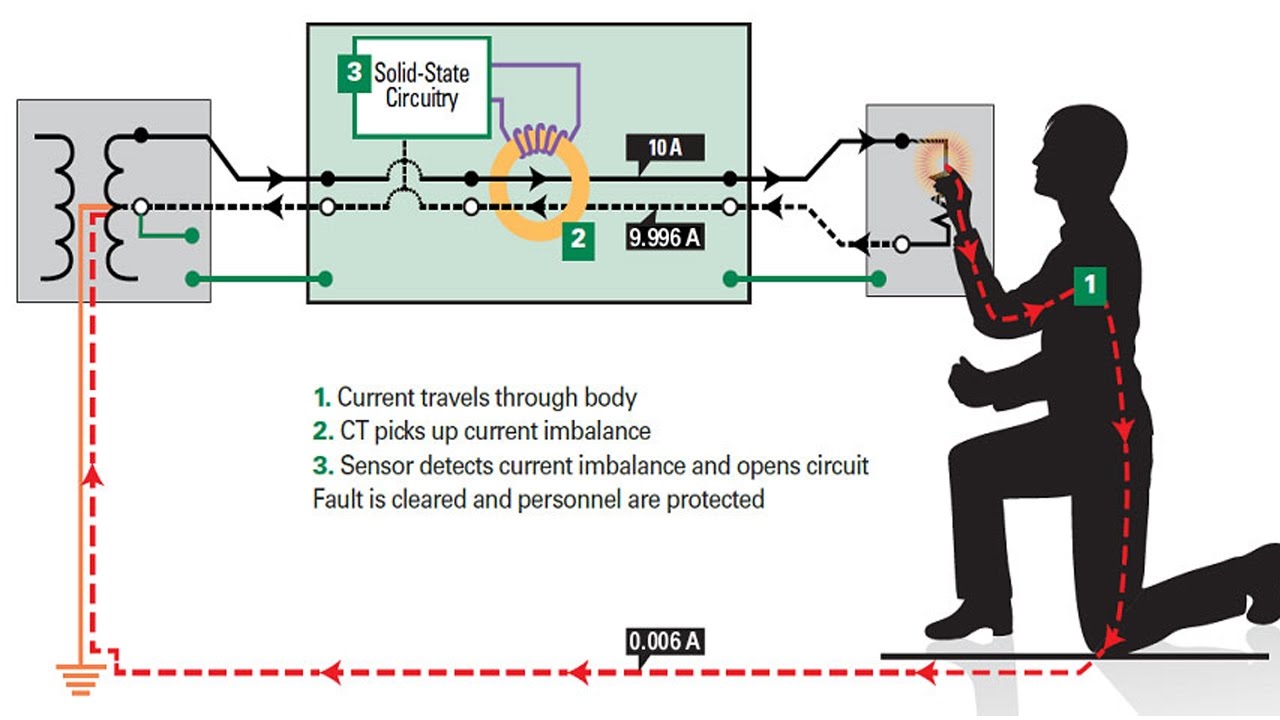Residual Current Circuit Breaker (RCCB) is a circuit-breaking device designed to protect people from electric shock and fire due to earth leakage. It cuts off the electrical current when a fault is detected in the wiring system. RCCBs provide an extra layer of protection that can save lives in the event of an electrical accident. They are commonly used in homes, businesses, and industrial environments.
This article will discuss the working principle and applications of RCCB in detail. Additionally, it will also provide benefits of RCCB and the difference between RCCB and RCBO.
What is a Residual Current Circuit Breaker (RCCB)?
A Residual Current Circuit Breaker (RCCB) is an electrical safety device that detects and trips against any low voltage (uneven current) circuit. It works by sensing the current in the circuit, and if it detects a residual current, it will automatically disconnect the power supply to help protect people from electric shock. RCCBs are commonly used in homes, businesses, and industrial facilities to ensure safety from electrical hazards.

They are also known as Earth Leakage Circuit Breakers (ELCBs) or Ground Fault Circuit Interrupters (GFCIs). RCCBs protect against electric shocks, fire hazards, and other potentially dangerous situations caused by faulty wiring or overloaded circuits. Installing an RCCB is a great way to protect your home or business from potential electrical hazards.
Working Principle of Residual Current Circuit Breaker with circuit diagram
A Residual Current Circuit Breaker (RCCB) is a safety device that protects people from electric shock caused by the uneven current in an electrical circuit. It works on the principle of Kirchhoff’s current law, which states that the incoming current must be equal to the outgoing current in any closed-loop circuit.

The RCCB contains two coils, a primary and secondary coil, wrapped around a core. When there is no fault in the circuit, both coils will carry an equal amount of current. If there is an imbalance or ‘leakage’ in the circuit due to a fault, then the secondary coil will detect this and trip the breaker. This quick response time ensures that people are kept safe from electric shocks.
Selection Principle of Residual Current Circuit Breaker
A Residual Current Circuit Breaker (RCCB) is an essential safety device that protects electrical circuits from damage caused by leakage current. The RCCB works on the principle of Kirchhoff’s law, which states that the incoming current should be equal to the outgoing current in a circuit. This type of circuit breaker can be used in both high-voltage and low-voltage power grids and is designed to detect any imbalance in the current and automatically trip when it reaches a certain threshold level.

When choosing a Residual Current Circuit Breaker, several factors need to be considered, such as the purpose of use, the location of electrical equipment, and the type of system being used. Voltage-type RCCBs are typically used for low-voltage power grids with no neutral point present, while Earth Leakage Circuit Breakers (ELCBs) are mostly employed for high-voltage grids with a neutral point available. Additionally, RCBOs offer both overload protection and residual current protection and provide better safety than regular RCDs or RCCBs.
Overall, selecting the right residual current circuit breaker according to your needs is essential for ensuring proper safety measures when using electrical systems. These devices can help prevent serious accidents or damage due to electric shock or fire caused by uncontrolled currents in circuitry.
Advantages and Disadvantages of RCCB
A Residual Current Circuit Breaker (RCCB) is an essential safety device for electrical circuits’ protection. It detects earth leakage and shuts off the circuit if the rated sensitivity is exceeded, thus preventing electrocution and fire. An RCCB also offers greater reliability than separate fuses or circuit breakers, as it will detect earth leakage from one or multiple sources in an installation.
However, RCCBs has some limitations. They do not provide short circuit or overload protection and cannot protect if the shock occurs between line and neutral. Additionally, they may not be suitable for applications where a large number of current needs to be switched on/off quickly as they may trip too slowly in these cases.

Overall, RCCBs offer great benefits in protecting people and property from electric shocks and fires. They are reliable, cost-effective solutions that provide a high level of safety.
Residual Current Circuit Breaker with Over Current Protection (RCBO)
A Residual Current Circuit Breaker with Overcurrent Protection (RCBO) is an electrical device that combines a residual current device (RCD) and a mini circuit breaker (MCB). This device is used to protect people from electric shock due to leakage currents and also provides protection against overcurrents and short circuits.

It works by detecting any leakage current in the circuit, which can be caused by faulty insulation or other problems, and automatically disconnecting the power supply when it reaches a certain level. This helps prevent shocks from occurring and reduces the risk of fire or damage to electrical equipment.
RCBOs are commonly used in home installations, industrial applications, commercial buildings, public areas, laboratories, and anywhere else where there is a need for reliable protection against both earth leakage currents and overcurrents.